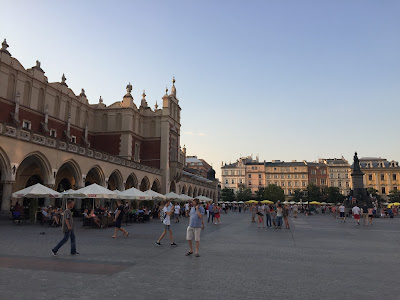 Arriving in Krakow, we were met with unseasonably high temperatures
in the mid-30s. Nonetheless, we doused
ourselves in sunscreen and headed out for a quick bite before meeting our
afternoon walking tour. The vegan
burger joint, Krowarzywa, in the Old Town was promoted as the best in Poland
but nothing could compare to the burgers we enjoyed in Warsaw. And the size of these ones made for such
messy eating that we needed a full wash down in the bathroom afterwards!
Arriving in Krakow, we were met with unseasonably high temperatures
in the mid-30s. Nonetheless, we doused
ourselves in sunscreen and headed out for a quick bite before meeting our
afternoon walking tour. The vegan
burger joint, Krowarzywa, in the Old Town was promoted as the best in Poland
but nothing could compare to the burgers we enjoyed in Warsaw. And the size of these ones made for such
messy eating that we needed a full wash down in the bathroom afterwards!
Although Krakow is Poland’s second largest city, it felt
much busier and fuller than larger Warsaw, with hordes of tourists buzzing around
the Old Town’s enormous town square.
 Measuring 200 square metres, Krakow’s main square is the largest in Europe and a natural stage for public celebrations and
gatherings. In the centre of the square
is the Cloth Hall, which was built in the 14th century and is
considered one of the first “shopping malls” in the world. It still serves as a marketplace, crammed
with stalls and vendors selling the latest trinkets. Outside the market hangs a knife, said to
have been used in an ancient legend, and a reminder to all that enter the
consequences of theft!
Measuring 200 square metres, Krakow’s main square is the largest in Europe and a natural stage for public celebrations and
gatherings. In the centre of the square
is the Cloth Hall, which was built in the 14th century and is
considered one of the first “shopping malls” in the world. It still serves as a marketplace, crammed
with stalls and vendors selling the latest trinkets. Outside the market hangs a knife, said to
have been used in an ancient legend, and a reminder to all that enter the
consequences of theft!
In the heart of the square sits St. Mary’s Basilica. The basilica has two towers, which are oddly different
sizes and said to be the result of two warring brothers who competed to create
the best tower and which ultimately resulted in one committing suicide. Or so the legend goes….
Every hour on the hour, the Krakow anthem is trumpeted from
one of the towers. The anthem, however,
is always cut short to commemorate a trumpeter who was shot in the neck while
warning the city of a Mongol invasion in the 1200s. Or so the legend goes…
A short stroll away from the main square sits the 650
year-old Jagiellonian University which Is one of the oldest universities in the
world (and the second oldest in Europe) and has hosted students such as
Copernicus and Pope John Paul II. During
WWII, when the Germans occupied Krakow, one of their first acts was to bring in
all of the professors for a “lecture” on university teachings during the new Nazi
era which was rather a cover to promptly arrest all of the professors in order
to stop the influence of all of these important thought leaders.
 Although the Nazis took swift and violent action in Krakow,
the majority of the city’s infrastructure survived relatively unscathed through
the War. Krakow’s closer proximity to
Germany was of real appeal and, as such, upon conquering the city, Hitler
promptly changed Krakow to become Poland’s capital and thus moved all official
government duties to the city.
Although the Nazis took swift and violent action in Krakow,
the majority of the city’s infrastructure survived relatively unscathed through
the War. Krakow’s closer proximity to
Germany was of real appeal and, as such, upon conquering the city, Hitler
promptly changed Krakow to become Poland’s capital and thus moved all official
government duties to the city.
As part of this decree, Hitler appointed Hans Frank – his
legal advisor – to become the Governor General of Krakow and installed him at
Wawel Hill, the traditional place of Poland’s royal monarchs and the site of
the Royal Palace. Not only filled with
national treasures, Wawel Hill is also the place where Polish influencers and
royalty are laid to rest. During the
war, the Palace not only remained free from harm but also underwent many
renovations and upgrades, in stark contrast to much of the rest of Poland.
The combination of jarring history, intense sun and a very
long walk around the Old Town and up and down Wawel Hill made us yearn for a shaded
seat and a treat and a very random banana split. Or so the legend goes…









No comments:
Post a Comment